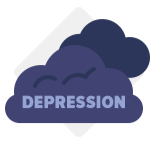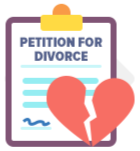Happiness is shaped by a mix of internal and external factors. We can boost it by approaching situations positively or choosing to spend time with people we love, doing activities we enjoy. However, other things are out of our control, like the cost-of-living crisis or record-high economic uncertainty – and they have taken a toll, with only 44% of Americans saying they are “very satisfied” with their lives.
Even though people across the U.S. are facing difficult times, the state in which you live may have an impact on how happy you are. In this study, WalletHub drew upon the findings of “happiness” research to determine which environmental factors are linked to a person’s overall well-being and satisfaction with life. Previous studies have found that good economic, emotional, physical and social health are all key to a well-balanced and fulfilled life.
To determine where Americans exhibit the best combination of these factors, we examined the 50 states across 30 key metrics, ranging from the depression rate and the share of adults feeling productive to income growth and the unemployment rate.

Chip Lupo, WalletHub Analyst
Main Findings
Happiest States in the U.S.
| Overall Rank* | State | Total Score | Emotional & Physical Well-Being Rank | Work Environment Rank | Community & Environment Rank |
|---|---|---|---|---|---|
| 1 | Hawaii | 65.50 | 2 | 16 | 13 |
| 2 | Maryland | 64.13 | 3 | 14 | 10 |
| 3 | Nebraska | 63.61 | 9 | 7 | 4 |
| 4 | New Jersey | 63.42 | 1 | 23 | 36 |
| 5 | Connecticut | 62.53 | 7 | 11 | 8 |
| 6 | Utah | 61.12 | 26 | 1 | 1 |
| 7 | California | 60.09 | 4 | 45 | 11 |
| 8 | New Hampshire | 59.56 | 15 | 10 | 7 |
| 9 | Massachusetts | 59.19 | 8 | 6 | 31 |
| 10 | Idaho | 58.31 | 29 | 2 | 2 |
| 11 | Minnesota | 58.21 | 11 | 12 | 19 |
| 12 | Delaware | 56.07 | 13 | 24 | 20 |
| 13 | South Dakota | 55.93 | 30 | 3 | 6 |
| 14 | Florida | 55.86 | 6 | 21 | 47 |
| 15 | Virginia | 55.45 | 12 | 17 | 37 |
| 16 | New York | 55.42 | 5 | 42 | 45 |
| 17 | Iowa | 55.42 | 21 | 22 | 9 |
| 18 | Pennsylvania | 54.73 | 14 | 31 | 16 |
| 19 | Georgia | 53.88 | 17 | 25 | 25 |
| 20 | Wisconsin | 53.62 | 24 | 13 | 28 |
| 21 | North Dakota | 53.43 | 20 | 9 | 41 |
| 22 | Illinois | 53.38 | 10 | 35 | 43 |
| 23 | Arizona | 52.89 | 16 | 27 | 32 |
| 24 | Washington | 52.88 | 18 | 36 | 18 |
| 25 | South Carolina | 52.82 | 25 | 20 | 17 |
| 26 | Rhode Island | 51.68 | 19 | 15 | 44 |
| 27 | Kansas | 51.29 | 27 | 19 | 29 |
| 28 | North Carolina | 50.97 | 22 | 28 | 33 |
| 29 | Vermont | 49.93 | 31 | 4 | 42 |
| 30 | Wyoming | 49.47 | 39 | 38 | 5 |
| 31 | Missouri | 48.31 | 35 | 18 | 26 |
| 32 | Montana | 47.83 | 45 | 5 | 21 |
| 33 | Maine | 47.64 | 36 | 8 | 40 |
| 34 | Indiana | 47.36 | 33 | 34 | 14 |
| 35 | Michigan | 47.06 | 34 | 43 | 12 |
| 36 | Oklahoma | 47.05 | 46 | 40 | 3 |
| 37 | Texas | 46.41 | 23 | 26 | 50 |
| 38 | Ohio | 45.67 | 38 | 39 | 22 |
| 39 | Oregon | 44.93 | 36 | 30 | 39 |
| 40 | Nevada | 44.82 | 40 | 44 | 24 |
| 41 | Colorado | 44.49 | 28 | 33 | 49 |
| 42 | Mississippi | 43.90 | 41 | 32 | 38 |
| 43 | Kentucky | 43.25 | 42 | 47 | 30 |
| 44 | New Mexico | 43.08 | 44 | 46 | 15 |
| 45 | Tennessee | 41.22 | 47 | 29 | 35 |
| 46 | Alaska | 40.69 | 32 | 48 | 48 |
| 47 | Alabama | 40.69 | 43 | 41 | 46 |
| 48 | Arkansas | 37.03 | 48 | 37 | 34 |
| 49 | Louisiana | 34.26 | 49 | 49 | 23 |
| 50 | West Virginia | 32.04 | 50 | 50 | 27 |
Notes: *No. 1 = Happiest
With the exception of “Total Score,” all of the columns in the table above depict the relative rank of that state, where a rank of 1 represents the best conditions for that metric category.

- Lowest
- 1. New Jersey
- 2. Hawaii
- T-3. Florida
- T-3. New York
- 5. California

- Highest
- 46. Oregon
- 47. Vermont
- T-48. Maine
- T-48. Tennessee
- 50. West Virginia

- Highest
- 1. Vermont
- 2. Minnesota
- 3. Colorado
- 4. Nebraska
- 5. Oregon

- Lowest
- T-45. Arkansas
- T-45. Ohio
- 47. Louisiana
- 48. Alabama
- 49. West Virginia
- 50. Hawaii

- Highest
- 1. Utah
- 2. Colorado
- 3. Washington
- 4. Montana
- 5. Oregon

- Lowest
- 46. Louisiana
- 47. West Virginia
- 48. Oklahoma
- 49. Arkansas
- 50. Mississippi

- Lowest
- 1. New Jersey
- 2. New York
- 3. Massachusetts
- 4. Connecticut
- 5. Maryland

- Highest
- 46. New Mexico
- 47. Idaho
- 48. Wyoming
- 49. Montana
- 50. Alaska

- Fewest
- 1. Utah
- 2. Vermont
- T-3. Oregon
- T-3. Rhode Island
- T-5. California
- T-5. Connecticut

- Most
- T-45. Mississippi
- T-45. North Dakota
- T-47. Louisiana
- T-47. Wyoming
- 49. Texas
- 50. Alaska

- Lowest
- 1. South Dakota
- T-2. Montana
- T-2. Nebraska
- T-2. Vermont
- T-5. Iowa
- T-5. Maine

- Highest
- T-45. Nevada
- T-45. New York
- T-45. Washington
- 48. Illinois
- 49. New Jersey
- 50. California

- Highest
- 1. Idaho
- 2. Arizona
- 3. Florida
- 4. Washington
- 5. Rhode Island

- Lowest
- 46. Maryland
- 47. Connecticut
- 48. North Dakota
- 49. Wyoming
- 50. Alaska

- Highest
- 1. Utah
- 2. Vermont
- T-3. Minnesota
- T-3. Nebraska
- 5. Kansas

- Lowest
- 46. Florida
- 47. New Mexico
- 48. Alabama
- 49. Nevada
- 50. Rhode Island

- Lowest
- 1. Utah
- 2. New Jersey
- 3. North Dakota
- 4. Hawaii
- 5. Minnesota

- Highest
- 46. Florida
- 47. Mississippi
- 48. Louisiana
- 49. Nevada
- 50. New Mexico

- Safest
- 1. Vermont
- 2. New Hampshire
- 3. Maine
- 4. Massachusetts
- 5. Utah

- Least Safe
- 46. Florida
- 47. Arkansas
- 48. Texas
- 49. Mississippi
- 50. Louisiana
In-Depth Look at the Happiest States
Hawaii
Hawaii is the happiest state, living up to its reputation as an island paradise, with residents reporting the highest levels of life satisfaction in the nation and the second-lowest depression rate.
Hawaiians also enjoy great physical health, with around 85% of adults reporting that they are in good or better health, the 10th-best percentage in the nation. Hawaiians also have the longest life expectancy in the U.S., and nearly 72% of adults in the state report being active and productive on a daily basis.
To top things off, positive economic conditions help Hawaiians stay happy. Hawaii has one of the lowest unemployment rates in the nation, at 2.4%, as well as the second-highest share of households with an annual income above $75,000. This naturally leads to the state having the 11th-lowest share of adults with financial anxiety.
Maryland
Maryland is the second-happiest state, in part because it has one of the lowest unemployment rates in the nation, at 3.2%, along with the highest percentage of households earning over $75,000 per year. Maryland residents also post on social media about work-related stress less often than people in all but four other states, which shows that they have decent work conditions on top of job stability.
When surveyed about life satisfaction, Maryland residents report liking what they do and being motivated to achieve their goals at the third-highest rate in the U.S. The state also has the third-lowest share of people who report having traumatic events during their childhood, and the third-highest share of people who report having supportive relationships and love in their lives.
The Old Line State also has the fifth-lowest suicide rate in the country, which shows that people are generally having their mental health concerns addressed before they become overwhelming.
Nebraska
Nebraska is the third-happiest state, with the fourth-lowest unemployment rate, at 2.9%, and the second-highest economic security in the nation, which measures whether community members are employed, insured, and otherwise financially stable. The state also has the sixth-lowest depression rate and the ninth-highest share of adults reporting good or better health. All these factors come together to create the conditions for good mental health.
Residents of Nebraska also demonstrate their happiness in their marriages. The Cornhusker State has the sixth-lowest separation and divorce rate in the country, at around 18%.
Finally, when it comes to work-life balance, although Nebraskans work more hours per week than residents in most other states, they still get to enjoy the most leisure time in the nation.
Ask the Experts
Happiness is more than a feeling of joy or excitement. It relies on various aspects of a person’s life — from emotional well-being to job satisfaction. To expand the discussion, we asked a panel of experts to share their advice and insight on achieving overall happiness and career contentment. Click on the experts’ profiles to read their bios and responses to the following key questions:
- What are the key ingredients to a happy life?
- How important is money to people’s happiness?
- What are the secrets to career contentment?
- How much does where you live influence your happiness?
- What are some steps a person can take to improve and maintain their mental health?
Ask the Experts
Ph.D. - Associate Professor, Department of Psychological Science - University of North Carolina at Charlotte
Read More
Ph.D., Associate Professor of Sociology, Missouri State University
Read More
Ph.D., Professor (Retired), Psychology, Special Education - University of Tampa
Read More
Ph.D., LP, LSSP, NCSP - Associate Professor and Coordinator, School Psychology PhD Program; Director of Clinical Training, School Psychology, School of Social Work, Psychology, & Philosophy - Texas Woman's University
Read More
Frank Schultz Endowed Professor of Business, Culverhouse College of Business – University of Alabama
Read More
Ph.D. – Associate Dean of Social Sciences and Graduate Programs, Professor of Psychology – Loyola University Maryland
Read More
Methodology
In order to determine the happiest states in America, WalletHub compared the 50 states across three key dimensions: 1) Emotional & Physical Well-Being, 2) Work Environment and 3) Community & Environment.
We evaluated those dimensions using 30 relevant metrics, which are listed below with their corresponding weights. Each metric was graded on a 100-point scale, with a score of 100 representing maximum happiness.
Finally, we determined each state’s weighted average across all metrics to calculate its overall score and used the resulting scores to rank-order our sample.
Our analysis draws upon the findings of the following research, each of which has indicated a correlation between our data and happiness:
- Happy People Live Longer: Subjective Well-Being Contributes to Health and Longevity (Chan and Diener, 2010)
- Happiness from Ordinary and Extraordinary Experiences (Bhattacharjee and Mogilner, 2014)
- Sports Participation and Happiness: Evidence from U.S. Micro Data (Huang and Humphreys, 2010)
- Unhappy Cities (Glaeser, et al., 2014)
Emotional & Physical Well-Being - Total Points: 50
- Career Well-Being: Double Weight (~4.35 Points)
Note: This metric is based on Sharecare’s “Community Well-Being Index,” particularly the “Purpose” element, defined as “Liking what you do each day and being motivated to achieve your goals.” - Physical Health Index: Full Weight (~2.17 Points)
Note: This metric measures self-reported effects of disease on personal happiness. - Adverse Childhood Experiences: Full Weight (~2.17 Points)
- Share of Adult Depression: Quadruple Weight (~8.70 Points)
Note: This metric measures the share of adults aged 18 years and older who were diagnosed with depression. - Social Well-Being: Full Weight (~2.17 Points)
Note: This metric is based on Sharecare’s “Community Well-Being Index”, particularly the “Social” element, defined as “having supportive relationships and love in your life.” - Share of Adults with Alcohol Use Disorder: Double Weight (~4.35 Points)
- Adequate-Sleep Rate: Full Weight (~2.17 Points)
- Sports-Participation Rate: Full Weight (~2.17 Points)
- Share of Adults Feeling Active & Productive: Full Weight (~2.17 Points)
Note: This metric is based on Gallup’s “State of the States” poll and measures the share of state residents who reported feeling active and productive every day for seven days prior to polling. - Share of Adults with Mental Health Not Good: Triple Weight (~6.52 Points)
Note: Percentage of Adults With 14 or More Mental Unhealthy Days Reported in the Past Month. - Life Expectancy: Double Weight (~4.35 Points)
- Suicide Rate: Triple Weight (~6.52 Points)
- Food-Insecurity Rate: Full Weight (~2.17 Points)
Work Environment - Total Points: 25
- Number of Work Hours: Double Weight (~5.00 Points)
- Commute Time: Half Weight (~1.25 Points)
- Share of Households Earning Annual Incomes Above $75,000: Full Weight (~2.50 Points)
- Share of Adults with Financial Anxiety: Half Weight (~1.25 Points)
Note: This metric measures the percentage of adults who agree that thinking about their personal finances makes them feel anxious. - Current Unemployment Rate: Half Weight (~1.25 Points)
- Share of Civilian Labor Force Unemployed 15 Weeks or Longer: Half Weight (~1.25 Points)
- Underemployment Rate: Full Weight (~2.50 Points)
- Job Security: Full Weight (~2.50 Points)
Note: This metric measures the probability of unemployment. - Share of Work-Related Stressed Tweets: Full Weight (~2.50 Points)
Note: This metric is based on PlushCare’s analysis of retrieved geotagged tweets from 340 major cities in the U.S. - Income-Growth Rate: Half Weight (~1.25 Points)
- Economic Security: Full Weight (~2.50 Points)
Note: This metric is based on Sharecare’s “Community Well-Being Index”, particularly the “Economic Security” element, defined as “community members who are employed, insured, and otherwise stable financially.” - Median Credit Score: Half Weight (~1.25 Points)
Community & Environment - Total Points: 25
- Volunteer Rate: Half Weight (~1.67 Points)
- Ideal Weather: Triple Weight (~10.00 Points)
Note: This metric is based on WalletHub’s “Cities with the Best & Worst Weather” ranking and was calculated as the average of the ranking for the top three cities by population in the state. - Average Leisure Time Spent per Day: Double Weight (~6.67 Points)
- Separation & Divorce Rate: Full Weight (~3.33 Points)
- Safety: Full Weight (~3.33 Points)
Note: This metric is based on WalletHub’s “Safest States in America” ranking.
Sources: Data used to create this ranking were collected as of June 23, 2025 from the U.S. Census Bureau, Bureau of Labor Statistics, Centers for Disease Control and Prevention, Feeding America, Gallup, TransUnion, Minnesota Population Center - University of Minnesota, Substance Abuse and Mental Health Services Administration, County Health Rankings, the Sharecare Community Well-Being Index, Data Resource Center for Child & Adolescent Health, FINRA Investor Education Foundation, PlushCare, AmeriCorps and WalletHub research.








WalletHub experts are widely quoted. Contact our media team to schedule an interview.